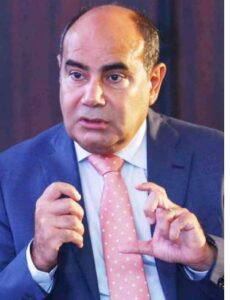Stakeholder consensus strongly suggests that MEP, the live element of any project, continues to face severe issues due to delayed payments and poor cashflow. Indu Revikumar, Features Writer, Climate Control Middle East, has the story…
As studies of facial expressions go, V Sekhar Reddy looks – and sounds – profoundly wistful when he points to the numerous instances of even major MEP players that have gone bust in recent times.
Reddy, a former MEP contractor, who has executed numerous District Cooling projects, among other works in the region, and is the Managing Director of Lexzander LLC, highlights the dwindling number of specialised MEP contractors, with the cashflow condition being directly responsible for it. “MEP, which has a major say in any project, and which is the live element of any project, is facing severe issues due to delayed payments and poor cashflow,” he says, adding that the delayed payments have a chain effect, as the contractor must pay MEP item vendors, key equipment vendors, sub-contractors and other parties. “If the contractor is not paid on time, they will not be able to fulfill their obligations to these parties, which can negatively affect project progress and quality,” he says. “Although contractors may receive some advance payment, it is often insufficient compared to the total amount invested in MEP deliverables. As a result, delayed payments can significantly impact the contractor’s performance on the project.”
Weighing in, Jeán van Loggerenberg, Partner, CKR Consulting Engineers, says that delayed payments have severely impacted the MEP industry. “Several MEP contractors and consultants,” he says, “have either closed their offices or left, leaving a huge impact on the quality of contractors and consultants in the market.” Outstanding talent and companies, he says, are necessary, especially to align with such important initiatives as UAE Vision 2021 and to enhance the UAE’s position as a global leader. He notes that many companies and talented individuals are leaving the country for better opportunities, margins, salaries and cashflow, available elsewhere. Therefore, it is imperative that changes are made to stem the flow and to attract others.

Raphael Khlat
Building on Reddy’s observation, Raphael Khlat, President, FJ Group, says that the delay in payments in the construction industry is not a new phenomenon – it has been around for some time. He elaborates that this is a general trend in the construction industry, and that contracts provide the developer with the ability to control payment issues as well as to delay payments, based on the contractor’s performance or the developer’s perception of it. “The contracts often make life difficult for contractors, especially the sub-contractors, who are at the end of the chain,” Khlat says. “The pandemic has exacerbated the situation, and many are struggling to finance projects due to lack of new jobs. Moreover, with fewer jobs available, the market has become highly competitive, leading to delays and failing projects that impact everyone.”
In addition, Khlat points out that banks do not adequately finance the construction industry, as doing so is considered a risky investment. He says that contractors are finding it increasingly challenging to secure financing, worsening the problem. He also notes that the industry needs to be better regulated, as the current system further disadvantages sub-contractors, contributing to the situation’s overall difficulty.

George Berbari
Meanwhile, George Berbari, CEO, DC PRO Engineering, shares an observation on the noticeable improvement in cashflow in recent years in Saudi Arabia, mainly as it is the biggest market. “While there have been some minor delays in the UAE, Qatar and Kuwait, the primary market with most improved payment rate is Saudi Arabia,” he says. “However, the payment rate in Saudi Arabia is yet to reach the level seen in the UAE, which has faster payment rates.”
Adding on to Khlat’s comments on contracts, Reddy says that though there have been efforts to address the issue related to cash flow by implementing payment procedures and contractual obligations, progress has been slow. “Even in everyday situations, like shopping, payment is expected immediately, and the same should be the case for MEP contractors who have already signed a contract,” Reddy adds.

V Sekhar Reddy
He also points out that it is vital to acknowledge the investment and time spent by MEP contractors, which is comparable to that of builders, even though the project cost for MEP is only around 30% of the total cost. “MEP contractors,” he says, “have a significant investment in the project, just like builders, and therefore, compensating them as per the contract is crucial for the project’s successful completion.”
Delayed payments are causing significant strain, eroding profit margins, and making it difficult to predict future outcomes, says Khlat. He adds that the situation is likely to be even more challenging with the impending introduction of taxation in 2024, requiring businesses to report financial data accurately. “Contractors and suppliers struggle to maintain financial stability, as payments are delayed beyond six or eight months,” he says. “In response, some businesses have begun removing these bills from their previous financials to avoid paying taxes on unrealised profits, and it will undoubtedly impact tax collection, unless the government makes specific allowances. Paying taxes on invoices that have not been collected will be challenging. It remains unclear how the issue will be resolved, but it is clear that the situation is not improving.”
Loggerenberg notes that delayed payments put pressure on the entire supply chain. Berbari points out that fiscal stress also stems from a decline in the number of projects, in addition to payment-related concerns. Berbari says, “The decreased volume could be insufficient to sustain the current level of consultants and contractors, exacerbating the financial difficulties being faced.”

Zaid Al Jabari
Adding to the discussion, Zaid Al Jabari, Managing Partner, ATS Advanced Technical Services, says that in the past eight years, the MEP construction market in the GCC region has encountered numerous difficulties, including global inflation, leading to higher material costs and wages, and global crises, affecting manufacturing, logistics and transportation. “MEP systems are often overlooked in the construction industry, leading to less budget allocation and challenging contracts for MEP contractors,” he says. “As a result, suppliers and small contractors are often managed in a price-oriented manner.” He adds that the main challenge arising from these situations is the cumulative misalignment of cashflow within the supply chain, which has exerted significant pressure on MEP contractors, caught among liabilities to OEMs, suppliers, contractors, specialists and the unstable financial commitments from upstream. “This has resulted in a lack of financial trust among parties, leading to cautious processes that increase overall costs and cause delays in procurement processes, including RFQs, LPOs, contracts and orders, until the final settlement of accounts,” he says. “All these processes are considered high-risk by the commercial departments of all involved parties.”
Cashflow trends of 2003-2008 and the current scenario
Loggerenberg reflects on the period between 2003 and 2008, when his firm was fortunate to be involved in some remarkable projects in the region. He remarks that the industry was different, and clients placed more obligation on the consultants regarding design responsibility and accountability. He says that there was more trust and respect for the profession, and even though there were some issues with cash flow, contracts were fair, and that everyone witnessed better cashflow than now. He also notes that 2003-2008 was when receiving fixed monthly free drawdowns on design programmes was typical, and prolongations during the design phase were infrequent. Moreover, he says, only a few layers of approval were required before the fees could be approved for the month. “The approval process, coupled with the general move to stage payments by clients, is making it very difficult for consultants to operate with sufficient cashflow in the current market,” he says.

Jeán van Loggerenberg
Reflecting on the period, Berbari says that 2003-2008 was a golden era for sub-contractors and developers, where everyone was focused on finishing projects quickly to cash in on the profits. He believes there is a need to return to a state of normalcy, where there is a constant flow of work and retention of the country’s MEP talents. “It is also important for the government to understand that maintaining a continuous flow of work is crucial for them,” he says. He notes that even now, the fees and contracting costs remain the same, though developers are struggling to find contractors and consultants.
The years between 2003 and 2008, Reddy says, indeed constituted a golden era for MEP contractors. The period was marked by high demand for MEP services and contractors, resulting in increased profit margins, he says. At the same time, he also highlights the downsides of the period, as clients and principal contractors were unhappy due to the high demands and perceived overcharging by MEP contractors. “This led to the introduction of nominated and domestic contractors, which also resulted in a decrease in quality standards and an increase in the copy-paste culture,” Reddy says. He adds that MEP contractors are crucial in ensuring that project elements are well-engineered, procured, installed, commissioned and handed over. “The period between 2003 and 2008 saw the rise and fall of many contractors, and the bad seasons that followed led to the exit of many skilled workers who worked for many MEP contractors,” he says. “However, this taught everyone the importance of consistency and quality in providing the right project for clients. While we are in a different phase, the industry will bounce back.”
Khlat provides a different viewpoint on the period between 2003 and 2008, when he says that it is challenging to offer a parallel, as each phase comes with its unique characteristics. He notes that the collapse in 2008 was the result of market inefficiencies and deficiencies in real estate and bank loans. “However, the current phase is different, and the real estate market is more saturated, with a focus on unique and quality construction and developments rather than just building to fill space,” he says. “Unlike in the past, where there were numerous unfinished projects, the current construction projects are more realistic and made after extensive studies.”
Lack of trust, undercutting, complacency
Loggerenberg says the MEP industry needs to come together to address another set of issues, prime among them being undercutting. He believes that unlike legal or medical professions, there is always someone who will try to undercut the other in the MEP industry. He adds that the MEP industry no longer considers terms such as value, capability or proven track record, as clients now prioritise the lowest price, “We see the impact of this in several projects, which are now facing problems in terms of poor construction quality and design issues,” he says.
Joining the discussion, Khlat says that the issue is not new in the industry, and consultants are often put under pressure to lower their prices. This, in turn, he says, can limit their ability to innovate. “To produce ingenious solutions, there is a certain investment required, and now, due to the lack of sufficient funds, consultants tend to replicate what they have been doing for so long,” he says. Cost consultants, he says, need to be gauged for building performance rather than simply designing the building without any responsibility for its actual performance or expenditure. “Considerations, such as installation, maintenance, operation and the building’s lifecycle are all crucial factors that should be considered, and they far outweigh any small cost savings that might be achieved by lowering consultant fees by one per cent,” he says. Often times, he says, consultants are forced to rush their designs, and contractors are left with greater responsibility for redesigning, refining and providing alternatives, which can impact the building’s performance. “Consultants should be held accountable for the performance of the building, rather than leaving contractors to bear the burden of accountability,” he says.
Reddy also shares a similar perspective that the lack of trust among stakeholders in the MEP industry is hampering progress and causing issues, including consultants undercutting each other’s jobs. He says that the industry has not learnt from past lessons, and all stakeholders must take responsibility for the current mess. “There is too much focus on paper titles and throwing correspondence back and forth, which leads to delays and a lack of progress,” he says. And clients, engineers, consultants, contractors, vendors and sub-contractors are all involved in this chain effect.”
To resolve this, Reddy says, the engineering side of the industry needs to play a neutral role in sorting out issues between clients and contractors and between contractors and sub-contractors. Everyone involved must also be willing to work together and trust each other, he says. He also points out that the payment process is a struggle, with everyone taking their positions and delays occurring, and one of the ways out for the industry is to learn from past mistakes and resolve issues as quickly as possible.
Reddy says the construction and MEP industries in the UAE still need to put on an improved showing when it comes to tackling issues related to Indoor Air Quality and energy management. By way of pointing some instances, Reddy says many buildings in Dubai’s JLT and Business Bay areas face issues relating to Indoor Air Quality and energy management that need to be resolved immediately. He notes that with the market going international, investors may lose confidence in the local industry, if things do not improve. “It is crucial to deliver quality work within the specified time and budget, or else confidence will be lost, and the industry’s reputation will suffer,” he says. He highlights that maintaining industry standards is crucial, especially with private investors entering the market. “The industry must exhibit competence and seriousness in upholding standards,” he says. “While government efforts have set minimum standards and procedures, they must also be effectively implemented.”
Improving MEP payment processes
So, what can be done to address cashflow and the numerous issues and sub-issues that concern MEP stakeholders? Do tools like AI and blockchain, and escrow accounts hold the key? Khlat says that even though various tools, such as AI and blockchain, can assist with payment processes in the MEP industry, the underlying problem lies with the lack of sufficient regulation and protection. He adds that as a provider of MEP equipment, FJ Group uses internal communication to determine good paymasters and set payment terms, accordingly. “However, this approach does not address the root of the issue, which starts with the developers, who hold the contracts,” he says. “Often, these contracts are sub-divided into numerous jobs, resulting in the developer attempting to funnel money outside the project and neglecting to pay the sub-contractors and suppliers involved in the main job.”
While tools like blockchain ledgers exist, Khlat says, they only solve the problem if there is a genuine desire and effort to implement a solution. He adds that developers must take the initiative to protect minor players, who are the most vulnerable to payment delays, and points out that one solution is to create a coalition among suppliers to rate contractors based on their payment performance. He also says that this approach can be challenging due to its legalities, “but informal communication and identification of good paymasters among industry players are still prevalent, highlighting the importance of honouring payment commitments in the industry”.
Khlat says the problem with payment processes in the MEP industry is not solely related to the lack of tools. It is a systemic issue that requires collaboration and cooperation from all stakeholders to ensure fair and timely payments, he adds.
In Berbari’s view, AI tools are slowly but surely making their way into the payments and blockchain industries. He says automated payment systems, powered by AI or blockchain, could streamline operations and improve efficiency. He notes that these could heavily benefit large-scale energy systems, like District Cooling schemes. However, there is a problem here, he says. Many of these systems are plagued by a fragmented approach, with several organisations trying to develop their own solutions, often without adequate support or instrumentation in place, and many buildings have faulty instrumentation, which can impede the functioning of AI. He adds that despite the potential benefits of AI, there is a lack of practical steps taken in this direction, with many organisations giving lip service rather than implementing changes. To elaborate, he points to the case of District Cooling utilities, which could save up to AED 200-300 million, annually, through AI applications. “Despite the potential for significant cost savings and improved profitability in the District Cooling industry through AI, there is a lack of interest in investing,” he says. “Moreover, the complacency of people and organisations in the industry needs to be dealt with, and a more proactive approach is required to promote environmental friendliness and reduced costs.”
Adding to the discussion, Reddy says that a handful of contractors are already using these tools. However, it is unlikely that everyone can afford this, nor do they have the energy to do it, he says. He points out that with meagre earnings, not all MEP contractors are in a position to update themselves or implement these tools, which are becoming increasingly important in the current world. “While some contractors have already adopted these systems, medium- to low-end contractors, who are a major support for the industry, may need help to keep up,” he says. “However, budgets can be tight, and not all companies can afford specialised workforces for such tools. It is crucial to make better use of specialised tools for the benefit of the client, project and system. Experience is essential but becomes meaningless, if expertise is not utilised effectively.”
Extending the discussion around improving the MEP payment process to escrow accounts, Khlat says that establishing an escrow account is one of the solutions that can be implemented to protect various suppliers. He adds that it has the added benefit of protecting the investors who have put money into a specific project by securing their investment. “It is good to consider this approach, and the responsibility of setting up and managing an escrow account lies with the developer,” he says. The developer, he says, must ensure that the payment process is transparent and that all the stakeholders are paid on time. “A proactive approach from the developer in providing payment will also improve the developer’s reputation and ensure better service quality, once the project is handed over,” Khlat says. “At the same time, it is important to understand that there are instances where a building has been taken over by a developer, who still owes 15-20% of the total value to the contractors, who are yet to be paid due to various reasons. It is necessary to have a fair mindset towards all stakeholders.”
Berbari says using escrow to resolve payment disputes is not the most efficient solution. Instead, he says, it would be more beneficial to have a fast-track legal system that can quickly and effectively deal with payment disputes to complete projects on time and with minimal delay. “Developers must also understand the urgency of paying on time, as delayed payments can result in significant losses, and they should be willing to pay proper engineering fees to consultants, as low fees can be detrimental to the quality of the project,” he says.
Berbari underlines how the government can facilitate this cultural change, by creating more balanced contracts and by establishing standard fees for consultants and contractors. Moreover, he believes that it will help ensure that everyone involved in a project is fairly compensated for their work, and that there is no undue bias towards one party. “Ultimately, the culture of cooperation and collaboration will result in faster project delivery, better return on investment and more efficient use of capital, so that the expertise gained in building these projects can be exported and utilised worldwide,” he says.
Reddy agrees that clients, engineers, contractors and sub-contractors should work collaboratively to make the payment process efficient, instead of solely relying on the client or the main contractor to ensure timely payment. He adds that sub-contractors must also take responsibility to speed up the process effectively, and it is essential to ensure that the project fund is utilised appropriately, as the client invests in a project for future returns. “If the project is not delivered on time or payment is delayed, it can cause significant challenges for the client,” he says. “Therefore, it is crucial to adopt a team approach and ensure that each party takes responsibility for its respective tasks. The contractor must deliver the project, the engineer must administer it and the client must pay on time through the engineer to the respective parties.”
Addressing challenges, achieving goals
Besides teamwork, there is a need for transnational flexibility and internal cash flow management structures, Berbari says. “The future looks grim, and I would quote the saying, ‘survival of the fittest’,” he says, while referring to current challenges confronting the MEP industry. The MEP industry, he says, faces difficulty in mobilising contractors across countries due to competitive rosters and due to restrictions in shifting a contracting company from one country to another. “For instance, many projects are being built in remote areas in Saudi Arabia, like Neom,” he says. “However, it remains unclear if these projects will have a cap on employees or adopt the hire-and-fire model that has worked well in the United States.”
Berbari underlines the importance of cashflow management and recommends that companies retain as much cash as possible, take out employment insurance, keep aside salaries for at least 3-6 months and build reserves for end-of-service payments. “Companies must manage multi-channel cashflow to build their stamina, which can take a decade,” he says. “The maximum allowed profit extraction in the construction industry should be 50% of annual profit and linked to cashflow above a certain threshold. Current cashflow regulations lead to many failures and struggles, and companies often resort to a snowball effect of using new job down payments to finance old jobs.”
Weighing in, Reddy says the MEP industry could overcome cashflow challenges through project partnerships, classification and rating of contractors and consultants, fixing a minimum value for a project with an escalation clause, ensuring transparency in payables and deductibles and through considering the financial and resource capabilities of contractors when awarding projects. Speaking from a broad perspective, Reddy says it is important for the MEP industry to focus on the core work than to get caught up in payment issues. “Specialists should be allowed to concentrate on their job, and training should be emphasised to keep up with advancements, such as the Internet of Things,” he says.
Loggerenberg, who is also the chair of the Dubai Construction Industry Business Group (Al Moltaka), which is registered through the Dubai Chamber of Commerce, says that one of the goals of the committee for this year is to arrange a roundtable discussion, to highlight the challenges the industry faces and to enable key stakeholders in the construction industry to provide feedback to the Government.
He says the time is ripe to address the situation of clients taking advantage of the situation, resulting in MEP consultants and contractors having to sign very one-sided contracts if wanting to be appointed on contracts. “Contracts should be fair, especially regarding payment terms and recourse for non-payment or delayed payment, and this needs to be addressed,” he says. “In terms of cashflow, it is straightforward. To quote the saying, ‘Turnover is vanity, profit is sanity, but cash is king for your business’.”
Copyright © 2006-2025 - CPI Industry. All rights reserved.